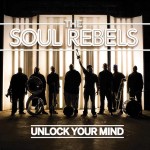After 20 years in existence, the Soul Rebels furiously unleash a barrage of musicianship, originality, and range of accomplishment every bit as impressive and inspiring as today’s historically black college and university marching show bands from which the Rebels draw inspiration. For example, a version of the Eurythmics’ signature 1983 hit “Sweet Dreams (Are Made of This)”, which opens with a brief, solemn, jazz funeral dirge before exploding into a cascading series of back-and-forth unison choruses, conjuring the image of tight-formation brass sections high-stepping and body-swiveling their way across a football field. Equally impressive, though, are standout examples of reggae rhythms, conga-drum percussion, hip-hop raps, old-school R&B and 1970s soul harmonies (Stevie Wonder’s “Living for the City” being an example), all purveyed within the musical context of studiously choreographed and well-rehearsed brass arrangements.
Sealing the deal is a series of celebrity cameos that weave their way through the album’s offerings. They include two generations of New Orleans funksters, with stirring solos by kindred spirit Trombone Shorty and Galactic saxophonist and producer Ben Ellman. The Neville Brothers’ gritty vocalist Cyril Neville sings on the title track, a 1970s soul hit from the Staples Singers, and the Meters’ jazz-inspired guitarist Leo Nocentelli co-produces his own, articulate paean to New Orleans’ Mardi Gras Indian street culture. Other standout tracks include a reggae-inflected version of the Allen Toussaint-penned Lee Dorsey hit “Night People”, a pair of triumphant, adult contemporary jazz raps shared equally by trombonist Corey Peyton and trumpeter Julian Gosin (“My Time Now” and “I Made It”); and a sleekly revived version of the band’s 1993 signature anthem, “Let Your Mind Be Free”.
Consistently straddling the well-established line between party and listening music, the Soul Rebels succeed transcendently by applying jazz-based intelligence and a synergistic whole-band mentality to easily accessible popular music of both old and new vintage. In the process, they’ve created a solid foundation for the development of a re-imagined New Orleans brass band tradition custom-made for a multicultural and multi-generational 21st Century.





